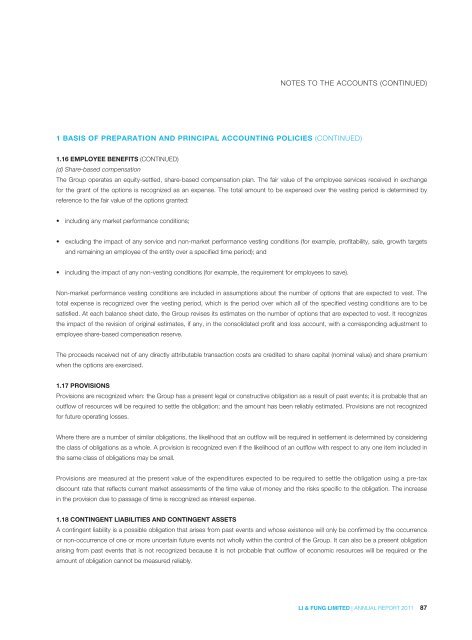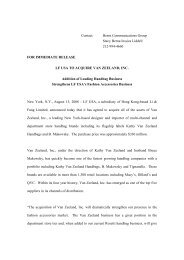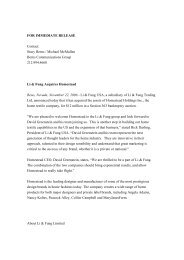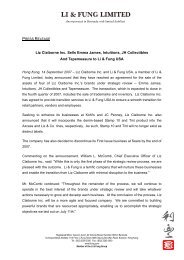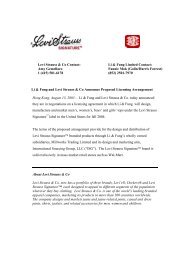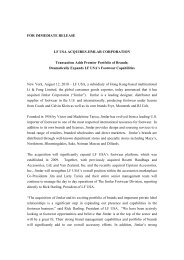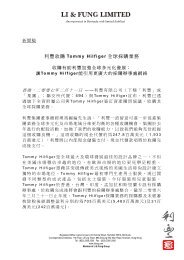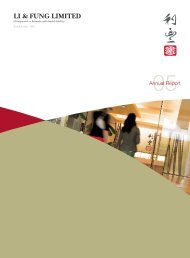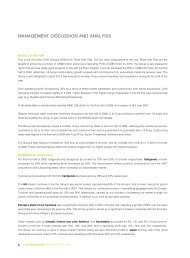2011 - Li & Fung Limited
2011 - Li & Fung Limited
2011 - Li & Fung Limited
- TAGS
- fung
- limited
- www.lifung.com
Create successful ePaper yourself
Turn your PDF publications into a flip-book with our unique Google optimized e-Paper software.
NOTES TO THE ACCOUNTS (CONTINUED)<br />
1 BASIS OF PREPARATION AND PRINCIPAL ACCOUNTING POLICIES (CONTINUED)<br />
1.16 EMPLOYEE BENEFITS (CONTINUED)<br />
(d) Share-based compensation<br />
The Group operates an equity-settled, share-based compensation plan. The fair value of the employee services received in exchange<br />
for the grant of the options is recognized as an expense. The total amount to be expensed over the vesting period is determined by<br />
reference to the fair value of the options granted:<br />
• including any market performance conditions;<br />
• excluding the impact of any service and non-market performance vesting conditions (for example, profitability, sale, growth targets<br />
and remaining an employee of the entity over a specified time period); and<br />
• including the impact of any non-vesting conditions (for example, the requirement for employees to save).<br />
Non-market performance vesting conditions are included in assumptions about the number of options that are expected to vest. The<br />
total expense is recognized over the vesting period, which is the period over which all of the specified vesting conditions are to be<br />
satisfied. At each balance sheet date, the Group revises its estimates on the number of options that are expected to vest. It recognizes<br />
the impact of the revision of original estimates, if any, in the consolidated profit and loss account, with a corresponding adjustment to<br />
employee share-based compensation reserve.<br />
The proceeds received net of any directly attributable transaction costs are credited to share capital (nominal value) and share premium<br />
when the options are exercised.<br />
1.17 PROVISIONS<br />
Provisions are recognized when: the Group has a present legal or constructive obligation as a result of past events; it is probable that an<br />
outflow of resources will be required to settle the obligation; and the amount has been reliably estimated. Provisions are not recognized<br />
for future operating losses.<br />
Where there are a number of similar obligations, the likelihood that an outflow will be required in settlement is determined by considering<br />
the class of obligations as a whole. A provision is recognized even if the likelihood of an outflow with respect to any one item included in<br />
the same class of obligations may be small.<br />
Provisions are measured at the present value of the expenditures expected to be required to settle the obligation using a pre-tax<br />
discount rate that reflects current market assessments of the time value of money and the risks specific to the obligation. The increase<br />
in the provision due to passage of time is recognized as interest expense.<br />
1.18 CONTINGENT LIABILITIES AND CONTINGENT ASSETS<br />
A contingent liability is a possible obligation that arises from past events and whose existence will only be confirmed by the occurrence<br />
or non-occurrence of one or more uncertain future events not wholly within the control of the Group. It can also be a present obligation<br />
arising from past events that is not recognized because it is not probable that outflow of economic resources will be required or the<br />
amount of obligation cannot be measured reliably.<br />
LI & FUNG LIMITED | ANNUAL REPORT <strong>2011</strong><br />
87


